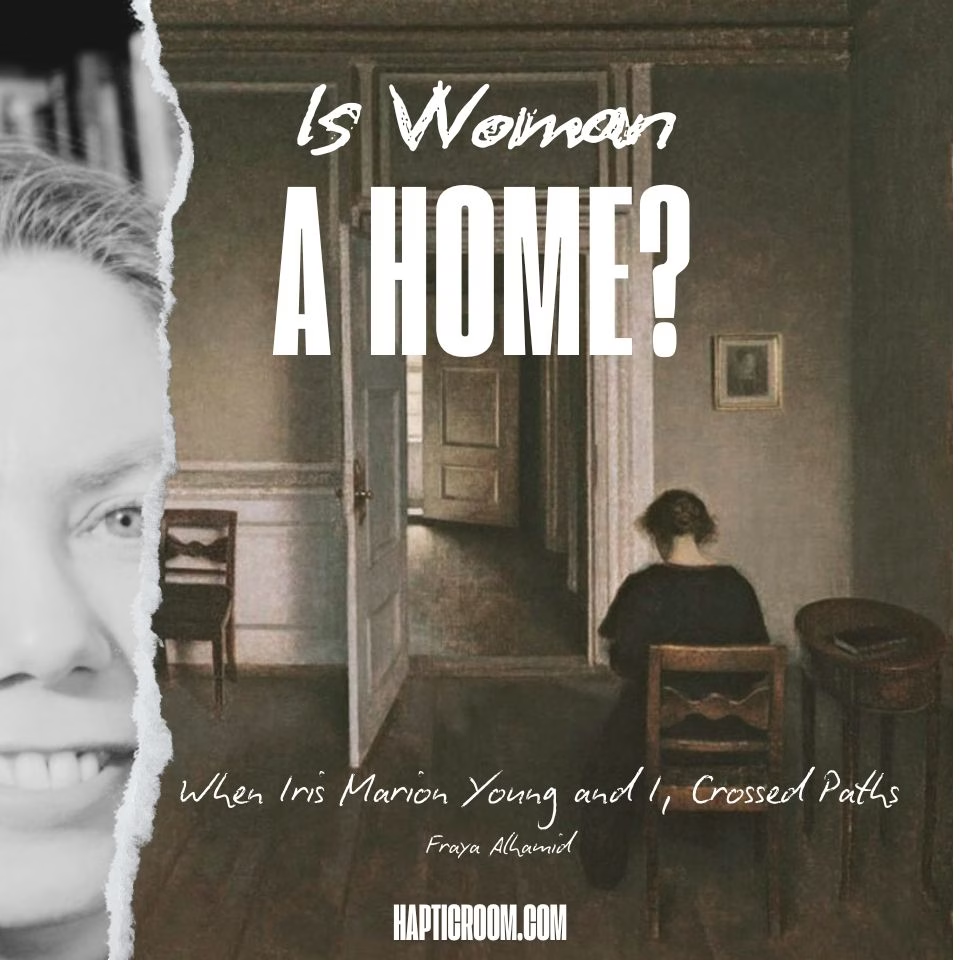When Iris Marion Young and I Crossed Paths
We might always be sensing that homemaking is at the hands of a woman. Coming home to a
place means coming home to mostly things women have touched. Iris Marion Young in her
essay narrates her analysis philosophically on this matter. How a place to live gets called a
home, and how it all historically begins. The values are projected in a home, not a house
because houses are built, and homes are nurtured and maintained. A demarcation between
who erected the building, and what belongs to a home which supports the cultural and
historical ideas of a woman’s identity represents a homemaker. This notion that somehow
inhabited a home, had stolen many women from their hope of pursuing their true identity.
Heidegger Through Iris Marion Young’s Reading : Men Building
Before I discovered that writing can alter many women’s reclused lives at home, I served years relinquishing the thought of who I was going to be. House was most of a wife’s life journey. Serving, and taking care of children and husband came as a priority. It will seem to be always a priority until one day we got lost in it. It dawns that once we cease searching for the authentic journey for ourselves, homemaking has spun onto women ultimately, completely, until loses all control of our own being, for numerous reasons. Young’s reading toward Heidegger -a reference from Luce Irigaray’s interpretation– of how being in the world of a man consists of dwelling and building in the world of patriarchal culture (Young, Throwing Like A Girl; On Female Body Experience,p.124). Further on, Iris suggests from Irigaray statement, all of this is at the expense of a woman’s service.
Women are seen as the pertaining order in nurturing. Being confined as part of the objects men keep and making nostalgic feels as if the sense of coming home to a “mother” would not be diminished. In dwelling and building, Iris portrays Heidegger’s views as man’s mode of being. There is duality in his meaning of building; cultivating and constructing. To establish his position in the world, as his place, an emergence of subjectivity that creates history and identity, while it appears that women ‘do not build’ (ibid,p.126).
A Confinement for Nostalgia
In traditional societies earlier, in Africa or Asia, women did build homes, until capitalism came with projects in the urban for migrated people all over the world. Women would still be in charge of the households in poorer rural homes. But the ownership of the land they lived in is not easy to claim. All due to male biases. Men are the first choice when it comes to construction development. They are assumed (by those in the universal male dimension) to be stronger and faster builders than women. Heidegger made his point of the other aspect of constructing which is preserving as a devaluation, says Iris. The gendered distinction between constructing and preserving.
Man is enveloped by being in the worlding world, that depends on a land that nurtures and maintains. According to Luce Irigaray, woman is always mother, a dark womb on which men emerge into the world to build and create solid structures in the light of the day, with whose light he returns to look in the caverns with speculum (ibid,p.128) Irigaray explains how man, when born in loss, he continued to seek the lost home (read: womb) as an escape for not wanting to deal with it.
Men projected themselves through building and bringing them as subjects that objectified women as part of their surroundings. So they put women in their buildings to feed the longing of nostalgia to return to the warmth of the womb of their mothers, but sadly fail in facing women as subjects with their own being, and not merely a reflection or a symbolic place. But is a woman a home with all the caretaking, comfort-giving, making sure whatever man required, woman obliged? Is a woman the property of man forever by being at home?
The Walls Are Closing In On Us: Women and Anxiety at Home
Men search for money outside with their shirts tucked beneath their trousers, and a belt
as their symbol of power and authority, rushing outdoors, accumulating what can be brought
home to a house, while their woman awaits him to return from his adventure. Iris Marion Young elaborates on what capitalism can do to revolutionize the definition of a house. Where commodified homes, such as apartments, flats, and condos are now what most people reside in. Leaving the historical houses where most of the activity, women and children can all freely conduct it outdoors (i.e : cooking, laundering, playing etc).
Commodified homes are less gendered to Marion, but a private place signifying one’s social status. It is for men and women with each of their specific lifestyle, and status and gets attached to them as part of personal identity (ibid,p.133) However, it does implicate women as to the reduction of space to become more confining than houses.
Do we ever ask ourselves what consequence it brings? The audacity of a man-made joke ; “Go back to the kitchen, where you belong.” The women who were oppressed internally, installing the best, suitable, stylish furnishings and perfecting tidy appearances of their home, humble-brag it as an obsession. A form of disguising the internal need to be seen, just to impress nobody is not only sad, but needed to be changed over time.
Deep down all of these, there are anxieties taking part in the routines that were only told ambiguously in movies or captured in one of the fiction noverls. Mental health is merely a cost women have to bound with. Implication for what it seem to be effortless moves in nurturing a home compared to the heroic, bread-winning actions men courageously fought for, away from home. Mental health took its toll with the increasing number of mothers who were vulnerable to depression compared to those who hustle and bustle working outside their homes (Zahra Nadri, Torabi, F., & Masoume Pirhadi. (2024)
Where Iris and I Crossed Paths
Iris Marion Young tells her childhood days with her mother in her essay; House and Home. This is where I crossed paths with her. Her mother was a stay-at-home mom in the 50’s. She had left her corporate work , from a Manhattan’s magazine office. She stayed with the kids while Iris’s father worked as an insurance underwriter, despite her intellectual abilities, speaking three languages and a master’s degree. Her appetite for knowledge seemed to be insatiable. This shows from the way Iris told the story of how her mother would teach Iris and her sisters hymn songs, introduce them to art and books, paint together, until filing papers with codes and calculations. There was only one thing she didn’t do: cleans the house.
Iris’s house was not only messy, but her mother did not cook, or did a proper housekeeping like any other housewives do. When their father passed away, she sunk into depression. She drinks. Cleaning was very much the last thing in her mind. Then police came and detained her in prison for child negligence. Iris and her sisters were sent to the teen-reform home.
“A woman alone with her children is liable to punishment, including the worst of all for her: having her children taken from her. – Iris Marion Young)”
As I jotted down these writings, I was sitting on an off-white stained IKEA couch staring at the
slight mess in my house. Books, papers, and boxes are stacked as my home horizons. Shoes lining up behind the front door. There’s a table mixer on the floor. Other small piles are on each of my wooden tables that I was also a little bothered by but couldn’t find a place to hide them. My “Marie Kondo” house assistant was losing her mood at this point and chose to go along with the unbearable mess. The effort to not make my children bothered by it is somewhat mid-successful in a way they didn’t seem to be embarrassed. The instinctively just bring their friends to the house, and so was I when accepting guests. We slowly let go of those standards.
What Our Mothers Taught Us : On Woman and Home
My mother taught me how to make the bed, clean up the room, and allowed her daughter to bake and cook occasionally at home. She didn’t project the narrow prospect of how a woman should be about
the house. She, herself was a busy entrepreneur and always hired more than one assistant to make up the house and everything else. We, her children, grow without being able to portray our mother as how a woman is when it comes about homemaking, but when my mother passed away our house lost its soul.
In 1978, Iris Marion Young’s mother died and she left a journal, her refusal to do housework as passive resistance. When replying to a question : is woman a home ? is like answering a temporality between immanence and transcendence. Women should never be a dichotomy of others. Woman should not be confined, and held from their own subjectivity to be whatever it is that she just haven’t decided yet.
‘Cause I’m too messy and then I’m too f**king clean
You told me get a job then you ask where the hell I’ve been
And I’m too perfect ’til I open my big mouth– Messy by Lola Young
References :
Iris Marion Young. (2005). On Female Body Experience. Oxford University Press.
Zahra Nadri, Torabi, F., & Masoume Pirhadi. (2024). A comparative analysis of stress, anxiety, and social well-being of working mothers and stay-at-home mothers during the covid pandemic. Journal of Education and Health Promotion, 13(1). https://doi.org/10.4103/jehp.jehp_220_23
Images :
The Banality of Everyday Life: Domestic Interiors painted by Vilhelm Hammershøi (1864-1916), and Picture of Iris Marion Young :Iris Marion Young – Feminista. (2010, July 28). Retrieved January 7, 2025, from Rafael Antonio Blanco website: https://tresando.com/2010/07/28/iris-marion-young-feminista/
Author: Fraya
A writer and entrepreneur with profound interest in humankind research and insights. An avid coffee drinker and book hoarder. Hours and days spent in Jakarta.The Haptic Room is supported by our readers. Our site may contain links to affiliate websites, and if you make a purchase through these links, we receive a commission to support our site.

